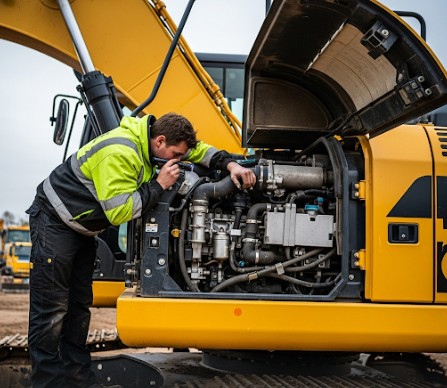
Excavating plants are the backbone of civil engineering projects, but like any powerful machine, they require regular care to perform at their best. Skipping maintenance can lead to costly breakdowns, reduced efficiency, and a shorter machine lifespan. A robust maintenance plan, however, ensures these giants keep running smoothly and reliably. This article is a guide to excavating plant maintenance, covering everything from daily checks to scheduled service and troubleshooting.
Daily and Weekly Checks
Simple, consistent checks by the operator are the first line of defense against major problems. Every day before work begins, you should do a walk-around inspection. Start by cleaning the undercarriage to prevent buildup of dirt and mud, which can cause excessive wear. Next, visually inspect the machine for any loose bolts, pins, or fasteners, tightening them as needed. Finally, check for any fluid leaks around the engine, hoses, and cylinders. Small leaks can quickly become big problems. On a weekly basis, you should perform more thorough checks, like inspecting the air filter and greasing all pivot points.
Scheduled Maintenance
While daily checks are reactive, scheduled maintenance is proactive and critical for long-term health. Manufacturers provide a maintenance schedule based on operating hours, and you must follow this schedule precisely. Key components like filters (air, fuel, hydraulic, and oil) need regular replacement. Clean filters ensure the engine and hydraulic systems remain free of contaminants, which extends their life. Likewise, all fluids, including engine oil and hydraulic fluid, must be changed at the specified intervals. Keeping a detailed service history for each machine is vital. A service log helps you track when each component was serviced, ensuring no critical maintenance task is missed.
Troubleshooting Common Issues
Even with regular maintenance, issues can arise. Knowing how to troubleshoot common problems can help you address minor issues before they escalate. For example, if the engine overheats, the first thing to check is the coolant level. If that’s okay, clean the radiator fins to ensure proper airflow. If the machine loses hydraulic power, inspect the hoses for leaks. A simple visual check can often reveal the problem. Unusual noises, such as a clunking or grinding sound, often indicate loose parts. You should stop the machine and inspect all connections to tighten any bolts or pins that have come loose. Early detection and simple fixes can prevent extensive damage.
Undercarriage Care
The undercarriage and tracks of an excavating plant are exposed to constant stress and wear, making their maintenance especially important. Proper tensioning of the tracks is crucial; if they are too tight, it increases wear on rollers and sprockets, and if they are too loose, they can come off. The manufacturer’s manual provides the correct tensioning procedure. Regular lubrication of all moving parts within the undercarriage also reduces friction and wear. Keep the undercarriage clean, and always inspect the tracks and rollers for damage. A well-maintained undercarriage ensures the machine remains stable and moves efficiently across any terrain.
References
- Caterpillar Inc. (2020). “Excavator Maintenance and Care.” Technical Manual.
- John Deere. (2021). “Operator’s Guide to Machine Maintenance.” Service Bulletin.
For more in-depth information on hydraulic systems and their maintenance, you can check out this resource on hydraulic system maintenance.
Leave a Reply